Distribution, Risk Assessment and Source of Heavy Metals in Mangrove Wetland Sediments of Dongzhai Harbor, South China
Abstract
1. Introduction
2. Materials and Methods
2.1. Study Area
2.2. Sampling and Analysis
2.3. Assessment Methodology
2.3.1. Geo-Accumulation Index
2.3.2. Potential Ecological Risk Index
2.4. Data Processing and Analysis
3. Results and Discussion
3.1. HM Concentrations in Sediments
3.2. Spatial Distribution of HMs
3.3. Geochemical Indicators Affecting HMs
3.4. HM Contamination Assessment
3.4.1. Geo-Accumulation Index
3.4.2. Potential Ecological Risk Index
3.5. Sources of HMs
4. Conclusions
Author Contributions
Funding
Institutional Review Board Statement
Informed Consent Statement
Data Availability Statement
Acknowledgments
Conflicts of Interest
Appendix A
| Soil Sample | As (μg/g) | Cd (μg/g) | Cr (μg/g) | Cu (μg/g) | Ni (μg/g) | Pb (μg/g) | Zn (μg/g) | pH | SAL (‰) | TP (μg/g) | TOC (%) | TN (%) |
|---|---|---|---|---|---|---|---|---|---|---|---|---|
| W1 | 16.3 | 0.14 | 97 | 24.9 | 47.1 | 25.3 | 89 | 7.98 | 4.4 | 820 | 1.706 | 0.1712 |
| W2 | 18.6 | 0.08 | 93 | 22 | 43.8 | 26.8 | 87 | 7.82 | 3.94 | 740 | 2.015 | 0.2234 |
| W3 | 16.2 | 0.06 | 65 | 14.3 | 29.1 | 20.4 | 63 | 7.52 | 3.71 | 600 | 1.784 | 0.182 |
| W4 | 17.7 | 0.08 | 77 | 17.6 | 36.4 | 24.3 | 80 | 7.56 | 3.86 | 730 | 1.364 | 0.1274 |
| W5 | 18.6 | 0.07 | 75 | 17.5 | 36.8 | 25.7 | 83 | 7.89 | 3.98 | 700 | 0.573 | 0.0528 |
| W6 | 18 | 0.06 | 53 | 11.8 | 22 | 20.2 | 48 | 8.01 | 3.12 | 430 | 0.673 | 0.0628 |
| W7 | 18.8 | 0.05 | 64 | 15.3 | 28.8 | 22.9 | 73 | 7.65 | 3.49 | 730 | 0.417 | 0.0428 |
| W8 | 17.1 | 0.04 | 58 | 12.8 | 25.4 | 21.3 | 59 | 7.66 | 3.24 | 540 | 1.007 | 0.1139 |
| W9 | 16.6 | 0.04 | 39 | 8.4 | 16.6 | 15.3 | 34 | 7.86 | 3.86 | 200 | 2.184 | 0.225 |
| W10 | 14.7 | 0.04 | 41 | 9.6 | 18.4 | 17.5 | 44 | 7.97 | 2.24 | 360 | 0.901 | 0.1023 |
| W11 | 14.6 | 0.05 | 38 | 8.3 | 14.7 | 16 | 40 | 7.78 | 2.07 | 310 | 2.505 | 0.1723 |
| W12 | 14.6 | 0.04 | 41 | 8.8 | 16.3 | 17.4 | 42 | 7.76 | 2.52 | 390 | 2.686 | 0.1967 |
| W13 | 17.2 | 0.04 | 44 | 10.3 | 19.4 | 19.4 | 46 | 8.11 | 2.41 | 400 | 2.285 | 0.1598 |
| W14 | 24.7 | 0.04 | 68 | 17.6 | 32.1 | 29.3 | 80 | 8 | 3.78 | 710 | 2.15 | 0.2278 |
| W15 | 15.8 | 0.04 | 52 | 11.5 | 22 | 20.5 | 58 | 7.77 | 2.63 | 500 | 1.869 | 0.192 |
| W16 | 18.5 | 0.04 | 57 | 13.2 | 25.5 | 23.4 | 66 | 7.76 | 3.01 | 570 | 1.196 | 0.1132 |
| W17 | 14.8 | 0.05 | 36 | 8.8 | 14.7 | 17.1 | 42 | 8.11 | 2.77 | 320 | 1.289 | 0.1023 |
| W18 | 21.7 | 0.08 | 61 | 14.7 | 27.3 | 25.4 | 67 | 7.91 | 4.07 | 370 | 1.361 | 0.1278 |
| W19 | 18.7 | 0.1 | 59 | 15.8 | 26.4 | 24.6 | 70 | 7.7 | 4.54 | 570 | 0.974 | 0.972 |
| W20 | 16 | 0.05 | 55 | 12 | 21.7 | 22 | 58 | 7.77 | 3.3 | 430 | 1.393 | 0.1293 |
| E1 | 15.5 | 0.11 | 92 | 27 | 42.5 | 29.1 | 85 | 7.6 | 4.21 | 770 | 3.699 | 0.2203 |
| E2 | 13.8 | 0.07 | 148 | 38.9 | 91.8 | 24.1 | 90 | 7.02 | 5.01 | 780 | 2.6467 | 0.1997 |
| E3 | 21.2 | 0.03 | 87 | 16.9 | 31.8 | 24.5 | 52 | 7.23 | 2.52 | 400 | 1.199 | 0.0927 |
| E4 | 14.6 | 0.07 | 96 | 23.5 | 48.4 | 25.7 | 81 | 7.33 | 3.67 | 800 | 2.5252 | 0.1715 |
| E5 | 14.8 | 0.07 | 106 | 29.6 | 50.5 | 31.8 | 105 | 7.48 | 4.67 | 1080 | 2.4328 | 0.1879 |
| E6 | 11.3 | 0.06 | 136 | 31.1 | 66.7 | 24.5 | 90 | 7.5 | 3.53 | 630 | 2.6501 | 0.1857 |
| E7 | 16.1 | 0.12 | 113 | 30.7 | 62.1 | 32.1 | 114 | 7.29 | 5.03 | 1190 | 2.9178 | 0.251 |
| E8 | 15.2 | 0.07 | 96 | 24.4 | 51 | 29.6 | 94 | 7.18 | 3.67 | 820 | 2.3518 | 0.1624 |
| E9 | 16.2 | 0.11 | 113 | 36.1 | 54.6 | 31.5 | 112 | 7.11 | 4.09 | 1290 | 3.1401 | 0.2462 |
| E10 | 14.2 | 0.04 | 102 | 27.4 | 53.7 | 30.6 | 98 | 6.9 | 3.44 | 870 | 3.3783 | 0.2353 |
| E11 | 16.4 | 0.13 | 121 | 36.4 | 67.1 | 33.2 | 123 | 7.04 | 4.75 | 1330 | 3.3651 | 0.2846 |
| E12 | 13.6 | 0.06 | 99 | 25.5 | 53 | 28.4 | 94 | 6.86 | 3.32 | 770 | 2.5819 | 0.1974 |
| E13 | 13.2 | 0.06 | 108 | 30.6 | 53.4 | 32.5 | 105 | 6.88 | 3.27 | 920 | 2.6617 | 0.2281 |
| E14 | 13 | 0.14 | 111 | 33.9 | 55.1 | 28.2 | 115 | 7.07 | 4.02 | 1180 | 3.6657 | 0.2535 |
| E15 | 16.7 | 0.1 | 119 | 32.3 | 62.2 | 29.8 | 112 | 7.13 | 4.08 | 1330 | 3.2988 | 0.265 |
| E16 | 14.6 | 0.14 | 124 | 39.1 | 68.1 | 40.9 | 127 | 6.72 | 4.25 | 1020 | 4.4975 | 0.3469 |
| E17 | 13.4 | 0.14 | 143 | 42.1 | 71.7 | 32.9 | 137 | 7.16 | 3.64 | 1570 | 3.2912 | 0.2698 |
| E18 | 12.3 | 0.1 | 138 | 39.8 | 71.5 | 28.7 | 118 | 6.84 | 3.83 | 1050 | 5.1179 | 0.3491 |
| E19 | 12.5 | 0.13 | 152 | 44.7 | 78 | 30.7 | 136 | 6.93 | 3.08 | 1110 | 4.1108 | 0.3256 |
| E20 | 13.4 | 0.1 | 146 | 45.4 | 78 | 32.3 | 136 | 6.9 | 3.04 | 1340 | 3.9179 | 0.305 |
| S1 | 11.6 | 0.09 | 127 | 29.1 | 60.9 | 29.6 | 112 | 7.19 | 1.72 | 1290 | 2.5249 | 0.2469 |
| S2 | 9.5 | 0.13 | 136 | 36.2 | 63.2 | 28.3 | 112 | 6.72 | 2.23 | 1180 | 2.9084 | 0.2473 |
| S3 | 10.4 | 0.07 | 100 | 23.7 | 44.7 | 26.2 | 85 | 6.47 | 2.89 | 780 | 3.4373 | 0.2686 |
| S4 | 10.9 | 0.04 | 102 | 22.7 | 46 | 26.9 | 86 | 6.76 | 1.82 | 740 | 1.9873 | 0.2055 |
| S5 | 10.2 | 0.03 | 89 | 18.1 | 39.4 | 25 | 72 | 7.02 | 1.66 | 570 | 1.6016 | 0.1687 |
| S6 | 10.8 | 0.14 | 137 | 33.4 | 73.9 | 29.9 | 116 | 6.68 | 2.83 | 1160 | 2.38 | 0.2476 |
| S7 | 13.1 | 0.09 | 117 | 26.7 | 55.4 | 30.2 | 104 | 6.09 | 2.93 | 1120 | 1.9653 | 0.2135 |
| S8 | 10.4 | 0.04 | 87 | 18.5 | 37.4 | 25.2 | 71 | 6.38 | 2.39 | 520 | 2.7368 | 0.1999 |
| S9 | 13.8 | 0.06 | 102 | 24.9 | 53.4 | 31.6 | 104 | 6.72 | 2.61 | 1070 | 1.9546 | 0.2064 |
| S10 | 9.6 | 0.04 | 83 | 17.2 | 35.1 | 25.6 | 63 | 6.72 | 2.49 | 480 | 2.5814 | 0.1921 |
| S11 | 14.4 | 0.05 | 91 | 20.8 | 41.4 | 28.6 | 91 | 7.41 | 2.44 | 1040 | 1.589 | 0.1578 |
| S12 | 12.4 | 0.06 | 96 | 21.5 | 44.2 | 28.9 | 95 | 7.3 | 2.13 | 900 | 1.9979 | 0.1825 |
| S13 | 12.1 | 0.06 | 81 | 17.6 | 36.7 | 26.0 | 81 | 6.08 | 2.87 | 840 | 1.6726 | 0.1867 |
| S14 | 13.3 | 0.05 | 83 | 18.8 | 40.0 | 28.7 | 86 | 6.47 | 2.73 | 980 | 1.7634 | 0.189 |
| S15 | 9.3 | 0.02 | 67 | 13 | 27.9 | 22.1 | 60 | 7.62 | 2.02 | 430 | 1.4358 | 0.1251 |
| S16 | 13.3 | 0.04 | 76 | 16.4 | 32.3 | 24.5 | 74 | 7.29 | 2.44 | 890 | 1.4365 | 0.1323 |
| S17 | 13.8 | 0.05 | 80 | 18.8 | 38.5 | 28.5 | 87 | 7.48 | 3.39 | 880 | 1.6162 | 0.1674 |
| S18 | 15.1 | 0.04 | 69 | 15.9 | 32.4 | 25.6 | 71 | 7.73 | 2.53 | 720 | 1.2178 | 0.1289 |
| S19 | 13.5 | 0.06 | 85 | 20 | 40.5 | 27.7 | 87 | 7.29 | 2.97 | 900 | 1.5651 | 0.1541 |
| S20 | 12.8 | 0.03 | 62 | 12.2 | 26.5 | 22 | 50 | 4.46 | 2.14 | 340 | 1.4682 | 0.0875 |
| Y1 | 6.4 | 0.02 | 105 | 18.5 | 40.8 | 28.2 | 62 | 4.89 | 0.72 | 180 | 0.6276 | 0.0705 |
| Y2 | 12.0 | 0.13 | 105 | 26.6 | 48.3 | 31.9 | 109 | 5.48 | 1.58 | 1900 | 2.6468 | 0.2749 |
| Y3 | 11.1 | 0.08 | 84 | 18.6 | 36.6 | 28.4 | 84 | 3.64 | 1.51 | 1200 | 2.0611 | 0.2345 |
| Y4 | 10.1 | 0.05 | 93 | 22.0 | 42.7 | 30.3 | 93 | 6.74 | 1.47 | 1680 | 1.9702 | 0.238 |
| Y5 | 10.9 | 0.12 | 88 | 23.0 | 41.7 | 30.2 | 102 | 7.28 | 2.26 | 1420 | 3.9958 | 0.3736 |
| Y6 | 9.7 | 0.02 | 83 | 20.8 | 37.3 | 28.5 | 70 | 5.86 | 1.42 | 890 | 1.8216 | 0.1981 |
| Y7 | 14.4 | 0.07 | 100 | 17.8 | 42.5 | 30.1 | 83 | 6.36 | 1.57 | 420 | 0.9789 | 0.1123 |
| Y8 | 12.7 | 0.07 | 93 | 22.3 | 44.0 | 31.2 | 100 | 5.43 | 2.57 | 1530 | 2.4606 | 0.2627 |
| Y9 | 14.8 | 0.06 | 86 | 19.9 | 41.6 | 29.8 | 90 | 6.29 | 2.4 | 1360 | 2.1396 | 0.2145 |
| Y10 | 7.4 | 0.02 | 71 | 12.6 | 25.4 | 26.4 | 46 | 4.36 | 2.54 | 270 | 1.4697 | 0.149 |
| Y11 | 9.3 | 0.02 | 72 | 15.8 | 31.9 | 26.2 | 65 | 5.79 | 1.31 | 550 | 2.8017 | 0.2062 |
| Y12 | 12.1 | 0.05 | 69 | 15.6 | 33.5 | 25.8 | 74 | 6.56 | 1.77 | 730 | 1.2296 | 0.1154 |
| Y13 | 9.2 | 0.06 | 67 | 14.8 | 31.6 | 25.4 | 69 | 6.69 | 2.07 | 580 | 2.0035 | 0.168 |
| Y14 | 13.3 | 0.05 | 80 | 18.7 | 38.0 | 29.9 | 88 | 6.49 | 2.88 | 850 | 1.964 | 0.1842 |
| Y15 | 10.1 | 0.04 | 65 | 13.9 | 30.0 | 24.0 | 71 | 6.91 | 1.78 | 550 | 1.3137 | 0.1274 |
| Y16 | 10.3 | 0.03 | 60 | 13.0 | 26.6 | 22.7 | 65 | 7.06 | 1.82 | 720 | 1.1585 | 0.1239 |
| Y17 | 10.1 | 0.06 | 62 | 14.1 | 27.9 | 23.4 | 66 | 7.13 | 2.58 | 550 | 1.8737 | 0.1644 |
| Y18 | 12.8 | 0.05 | 72 | 16.5 | 34.4 | 26.6 | 81 | 6.85 | 2.43 | 780 | 1.3922 | 0.1433 |
| Y19 | 6.2 | 0.03 | 39 | 7.8 | 16.8 | 16.0 | 43 | 6.79 | 1.54 | 380 | 0.6541 | 0.0628 |
| Y20 | 11.5 | 0.04 | 65 | 14.3 | 30.0 | 24.4 | 72 | 7.12 | 2.57 | 700 | 1.0852 | 0.1149 |
References
- Zhu, J.; Yan, B. Blue carbon sink function and carbon neutrality potential of mangroves. Sci. Total Environ. 2022, 822, 153438. [Google Scholar] [CrossRef] [PubMed]
- Fernández-Cadena, J.C.; Andrade, S.; Silva-Coello, C.L.; De la Iglesia, R. Heavy metal concentration in mangrove surface sediments from the north-west coast of South America. Mar. Pollut. Bull. 2014, 82, 221–226. [Google Scholar] [CrossRef] [PubMed]
- Wu, Q.; Tam, N.F.Y.; Leung, J.Y.S.; Zhou, X.; Fu, J.; Yao, B.; Huang, X.; Xia, L. Ecological risk and pollution history of heavy metals in Nansha mangrove, South China. Ecotoxicol. Environ. Saf. 2014, 104, 143–151. [Google Scholar] [CrossRef] [PubMed]
- Li, L.; Zhang, Y.; Ippolito, J.A.; Xing, W.; Qiu, K.; Yang, H. Lead smelting effects heavy metal concentrations in soils, wheat, and potentially humans. Environ. Pollut. 2020, 257, 113641. [Google Scholar] [CrossRef] [PubMed]
- Hosono, T.; Su, C.; Siringan, F.; Amano, A.; Onodera, S. Effects of environmental regulations on heavy metal pollution decline in core sediments from Manila Bay. Mar. Pollut. Bull. 2010, 60, 780–785. [Google Scholar] [CrossRef]
- Zhang, Z.; Xu, X.; Sun, Y.; Yu, S.; Chen, Y.; Peng, J. Heavy metal and organic contaminants in mangrove ecosystems of China, A review. Environ. Sci. Pollut. Res. 2014, 21, 11938–11950. [Google Scholar] [CrossRef]
- Zhang, C.; Yu, Z.; Zeng, G.; Jiang, M.; Yang, Z.; Cui, F.; Zhu, M.; Shen, L.; Hu, L. Effects of sediment geochemical properties on heavy metal bioavailability. Environ. Int. 2014, 73, 270–281. [Google Scholar] [CrossRef]
- Karppinen, E.M.; Payment, J.; Chatterton, S.; Bainard, J.D.; Hubbard, M.; Gan, Y.; Bainard, L.D. Distribution and abundance of Aphanomyces euteiches in agricultural soils, Effect of land use type, soil properties, and crop management practices. Appl. Soil Ecol. 2020, 150, 103470. [Google Scholar] [CrossRef]
- Wang, Y.; Qiu, Q.; Xin, G.; Yang, Z.; Zheng, J.; Ye, Z.; Li, S. Heavy metal contamination in a vulnerable mangrove swamp in South China. Environ. Monit. Assess. 2013, 185, 5775–5787. [Google Scholar] [CrossRef]
- Hu, B.; Guo, P.; Wu, Y.; Deng, J.; Su, H.; Li, Y.; Nan, Y. Study of soil physicochemical properties and heavy metals of a mangrove restoration wetland. J. Clean. Prod. 2021, 291, 125965. [Google Scholar] [CrossRef]
- Harbison, P. Mangrove muds—A sink and a source for trace metals. Mar. Pollut. Bull. 1986, 17, 246–250. [Google Scholar] [CrossRef]
- Liang, J.; Liu, J.; Xu, G.; Chen, B. Distribution and transport of heavy metals in surface sediments of the Zhejiang nearshore area, East China Sea, Sedimentary environmental effects. Mar. Pollut. Bull. 2019, 146, 542–551. [Google Scholar] [CrossRef]
- Tam, N.F.Y.; Yao, M.W.Y. Normalisation and heavy metal contamination in mangrove sediments. Sci. Total Environ. 1998, 216, 33–39. [Google Scholar] [CrossRef]
- Bayen, S. Occurrence, bioavailability and toxic effects of trace metals and organic contaminants in mangrove ecosystems, A review. Environ. Int. 2012, 48, 84–101. [Google Scholar] [CrossRef]
- Yan, L.; Xie, X.; Peng, K.; Wang, N.; Zhang, Y.; Deng, Y.; Gan, Y.; Li, Q.; Zhang, Y. Sources and compositional characterization of chromophoric dissolved organic matter in a Hainan tropical mangrove-estuary. J. Hydrol. 2021, 600, 126572. [Google Scholar] [CrossRef]
- Xia, D.; Vaye, O.; Yang, Y.; Zhang, H.; Sun, Y. Spatial distributions, source apportionment and ecological risks of C9–C17 chlorinated paraffins in mangrove sediments from Dongzhai Harbor, Hainan Island. Environ. Pollut. 2021, 270, 116076. [Google Scholar] [CrossRef]
- Ruan, S.; Luo, J.; Zhang, T.; Nordhaus, I.; Diao, X.; Zhao, H. Spatial and seasonal variations of chloramphenicol resistance genes and their co-occurring analysis with bacteria in a typical mangrove area of Hainan island, China. Estuar. Coast. Shelf Sci. 2020, 233, 106541. [Google Scholar] [CrossRef]
- Qiu, Y.; Yu, K.; Zhang, G.; Wang, W. Accumulation and partitioning of seven trace metals in mangroves and sediment cores from three estuarine wetlands of Hainan Island, China. J. Hazard. Mater. 2011, 190, 631–638. [Google Scholar] [CrossRef]
- Wang, L.; Liu, Y.; Ding, F.; Zhang, Y.; Liu, H. Occurrence and cross-interface transfer of phthalate esters in the mangrove wetland in Dongzhai Harbor, China. Sci. Total Environ. 2022, 807, 151062. [Google Scholar] [CrossRef]
- He, Y.; Guan, W.; Xue, D.; Liu, L.; Peng, C.; Liao, B.; Hu, J.; Zhu, Q.; Yang, Y.; Wang, X.; et al. Comparison of methane emissions among invasive and native mangrove species in Dongzhaigang, Hainan Island. Sci. Total Environ. 2019, 697, 133945. [Google Scholar] [CrossRef]
- Zhang, Y.; Xin, K.; Sheng, N.; Xie, Z.; Liao, B. The regenerative capacity of eight mangrove species based on propagule traits in Dongzhai Harbor, Hainan Province, China. Glob. Ecol. Conserv. 2021, 30, e01788. [Google Scholar] [CrossRef]
- Lu, Q.; Bai, J.; Zhang, G.; Wu, J. Effects of coastal reclamation history on heavy metals in different types of wetland soils in the Pearl River Delta: Levels, sources and ecological risks. J. Clean. Prod. 2020, 272, 122668. [Google Scholar] [CrossRef]
- Pan, F.; Liu, H.; Guo, Z.; Li, Z.; Wang, B.; Gao, A. Geochemical behavior of phosphorus and iron in porewater in a mangrove tidal flat and associated phosphorus input into the ocean. Cont. Shelf Res. 2017, 150, 65–75. [Google Scholar] [CrossRef]
- GB17378.5-2007; Specification for Marine Monitoring of China. Standards Press of China: Beijing, China, 2007.
- Muller, G. Index of geoaccumulation in sediments of the rhine river. GeoJournal 1969, 2, 109–118. [Google Scholar]
- Liao, X.; Ding, S.; Wu, D.; Feng, Y. Trace Element Geochemical Characteristics of the Soils in Northeastern Hainan. Chin. Agric. Sci. Bull. 2004, 68–71. (In Chinese) [Google Scholar]
- Wolswijk, G.; Satyanarayana, B.; Dung, L.; Siau, Y.; Ali, A.; Saliu, I.; Fisol, M.; Gonnelli, C.; Dahdouh-guebas, F. Distribution of mercury in sediments, plant and animal tissues in Matang Mangrove Forest Reserve, Malaysia. J. Hazard. Mater. 2020, 387, 121665. [Google Scholar] [CrossRef] [PubMed]
- Yao, W.; Hu, C.; Yang, X.; Shui, B. Spatial variations and potential risks of heavy metals in sediments of Yueqing Bay, China. Mar. Pollut. Bull. 2021, 173, 112983. [Google Scholar] [CrossRef] [PubMed]
- Chen, Q.; Zhao, B.; Zhang, Y.; Zhu, F.; Wang, H.; Wang, J.; Fu, X. The function of “Cambi® thermal hydrolysis + anaerobic digestion” on heavy metal behavior and risks in a full-scale sludge treatment plant based on four seasons investigation. J. Hazard. Mater. 2023, 445, 130579. [Google Scholar] [CrossRef]
- Wang, F.; Wang, F.; Yang, H.; Yu, J.; Ni, R. Ecological risk assessment based on soil adsorption capacity for heavy metals in Taihu basin, China. Environ. Pollut. 2023, 316, 120608. [Google Scholar] [CrossRef]
- Hakanson, L. An ecological risk index for aquatic pollution control.a sedimentological approach. Water Res. 1980, 14, 975–1001. [Google Scholar] [CrossRef]
- Yang, J.; Sun, Y.; Wang, Z.; Gong, J.; Gao, J.; Tang, S.; Ma, S.; Duan, Z. Heavy metal pollution in agricultural soils of a typical volcanic area, Risk assessment and source appointment. Chemosphere 2022, 304, 135340. [Google Scholar] [CrossRef]
- Tam, N.F.Y.; Wong, Y.S. Spatial variation of heavy metals in surface sediments of Hong Kong mangrove swamps. Environ. Pollut. 2000, 110, 195–205. [Google Scholar] [CrossRef]
- Yu, R.; Yuan, X.; Zhao, Y.; Hu, G.; Tu, X. Heavy metal pollution in intertidal sediments from Quanzhou Bay, China. J. Environ. Sci. 2008, 20, 664–669. [Google Scholar] [CrossRef]
- Miniero, R.; Ceretti, G.; Cherin, E.; Dellatte, E.; De Luca, S.; Ferri, F.; Fulgenzi, A.R.; Grim, F.; Iacovella, N.; Iamiceli, A.L.; et al. PCDD and PCDF intake through consumption of locally produced seafood by Venice lagoon residents, Elements for risk management. Mar. Pollut. Bull. 2005, 50, 1727–1732. [Google Scholar] [CrossRef]
- MacFarlane, G.R. Leaf biochemical parameters in Avicennia marina (Forsk.) Vierh as potential biomarkers of heavy metal stress in estuarine ecosystems. Mar. Pollut. Bull. 2002, 44, 244–256. [Google Scholar] [CrossRef]
- Zhang, Z.; Zhang, N.; Li, H.; Lu, Y.; Wang, Q.; Yang, Z. Risk assessment, spatial distribution, and source identification of heavy metal(loid)s in paddy soils along the Zijiang River basin, in Hunan Province, China. J. Soils Sediments 2019, 19, 4042–4051. [Google Scholar] [CrossRef]
- Zhao, G.; Ye, S.; Yuan, H.; Ding, X.; Wang, J.; Laws, E. Surface sediment properties and heavy metal contamination assessment in river sediments of the Pearl River Delta, China. Mar. Pollut. Bull. 2018, 136, 300–308. [Google Scholar] [CrossRef]
- Kehrig, H.A.; Pinto, F.N.; Moreira, I.; Malm, O. Heavy metals and methylmercury in a tropical coastal estuary and a mangrove in Brazil. Org. Geochem. 2003, 34, 661–669. [Google Scholar] [CrossRef]
- Sabiha, J.; Mehmood, T.; Chaudhry, M.M.; Tufail, M.; Irfan, N. Heavy metal pollution from phosphate rock used for the production of fertilizer in Pakistan. Microchem. J. 2009, 91, 94–99. [Google Scholar] [CrossRef]
- Zhou, Y.; Zhao, B.; Peng, Y.; Chen, G. Influence of mangrove reforestation on heavy metal accumulation and speciation in intertidal sediments. Mar. Pollut. Bull. 2010, 60, 1319–1324. [Google Scholar] [CrossRef]
- Dey, G.; Banerjee, P.; Maity, J.P.; Sharma, R.K.; Gnanachandrasamy, G.; Huang, Y.; Huang, H.; Chen, C. Heavy metals distribution and ecological risk assessment including arsenic resistant PGPR in tidal mangrove ecosystem. Mar. Pollut. Bull. 2022, 181, 113905. [Google Scholar] [CrossRef] [PubMed]
- Dan, S.F.; Udoh, E.C.; Wangm, Q. Contamination and ecological risk assessment of heavy metals, and relationship with organic matter sources in surface sediments of the Cross River Estuary and nearshore areas. J. Hazard. Mater. 2022, 438, 129531. [Google Scholar] [CrossRef] [PubMed]
- Duan, D.; Lan, W.; Chen, F.; Lei, P.; Zhang, H.; Ma, J.; Wei, Y.; Pan, K. Neutral monosaccharides and their relationship to metal contamination in mangrove sediments. Chemosphere 2020, 251, 126368. [Google Scholar] [CrossRef] [PubMed]
- Sundaramanickam, A.; Shanmugam, N.; Cholan, S.; Kumaresan, S.; Madeswaran, P.; Balasubramanian, T. Spatial variability of heavy metals in estuarine, mangrove and coastal ecosystems along Parangipettai, Southeast coast of India. Environ. Pollut. 2016, 218, 186–195. [Google Scholar] [CrossRef] [PubMed]
- Ray, R.; Mandal, S.; González, A.; Pokrovsky, O.; Jana, T. Storage and recycling of major and trace element in mangroves. Sci. Total Environ. 2021, 780, 146379. [Google Scholar] [CrossRef]
- Wu, H.; Liu, J.; Bi, X.; Lin, G.; Feng, C.; Li, Z.; Qi, F.; Zheng, T.; Xie, L. Trace metals in sediments and benthic animals from aquaculture ponds near a mangrove wetland in Southern China. Mar. Pollut. Bull. 2017, 117, 486–491. [Google Scholar] [CrossRef]
- Li, P.; Li, X.; Bai, J.; Meng, Y.; Diao, X.; Pan, K.; Zhu, X.; Lin, G. Effects of land use on the heavy metal pollution in mangrove sediments: Study on a whole island scale in Hainan, China. Sci. Total Environ. 2022, 824, 153856. [Google Scholar] [CrossRef]
- Zhang, M.; He, P.; Qiao, G.; Huang, J.; Yuan, X.; Li, Q. Heavy metal contamination assessment of surface sediments of the Subei Shoal, China, Spatial distribution, source apportionment and ecological risk. Chemosphere 2019, 223, 211–222. [Google Scholar] [CrossRef]
- Perumal, K.; Antonym, J.; Muthuramalingam, S. Heavy metal pollutants and their spatial distribution in surface sediments from Thondi coast, Palk Bay, South India. Environ. Sci. Eur. 2021, 33, 63. [Google Scholar] [CrossRef]
- Zhang, G.; Xue, G.; Ruan, M.; He, Y.; Lin, D.; Du, S. Phosphorus species, influencing and release risks assessment in mangrove wetland sediments of Dongzhai Harbor on Hainan island, China. Sustainability 2022, 14, 14344. [Google Scholar] [CrossRef]
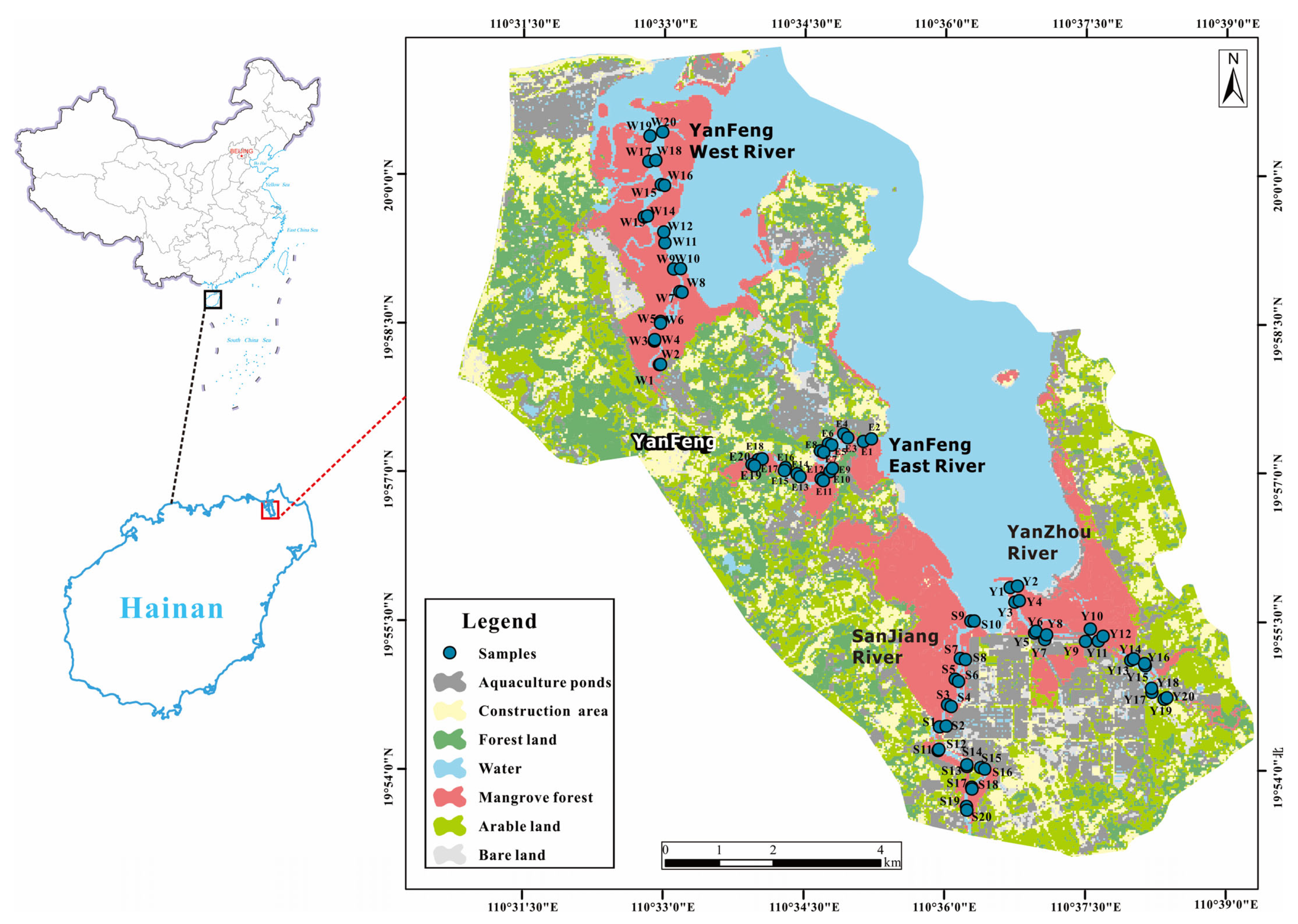
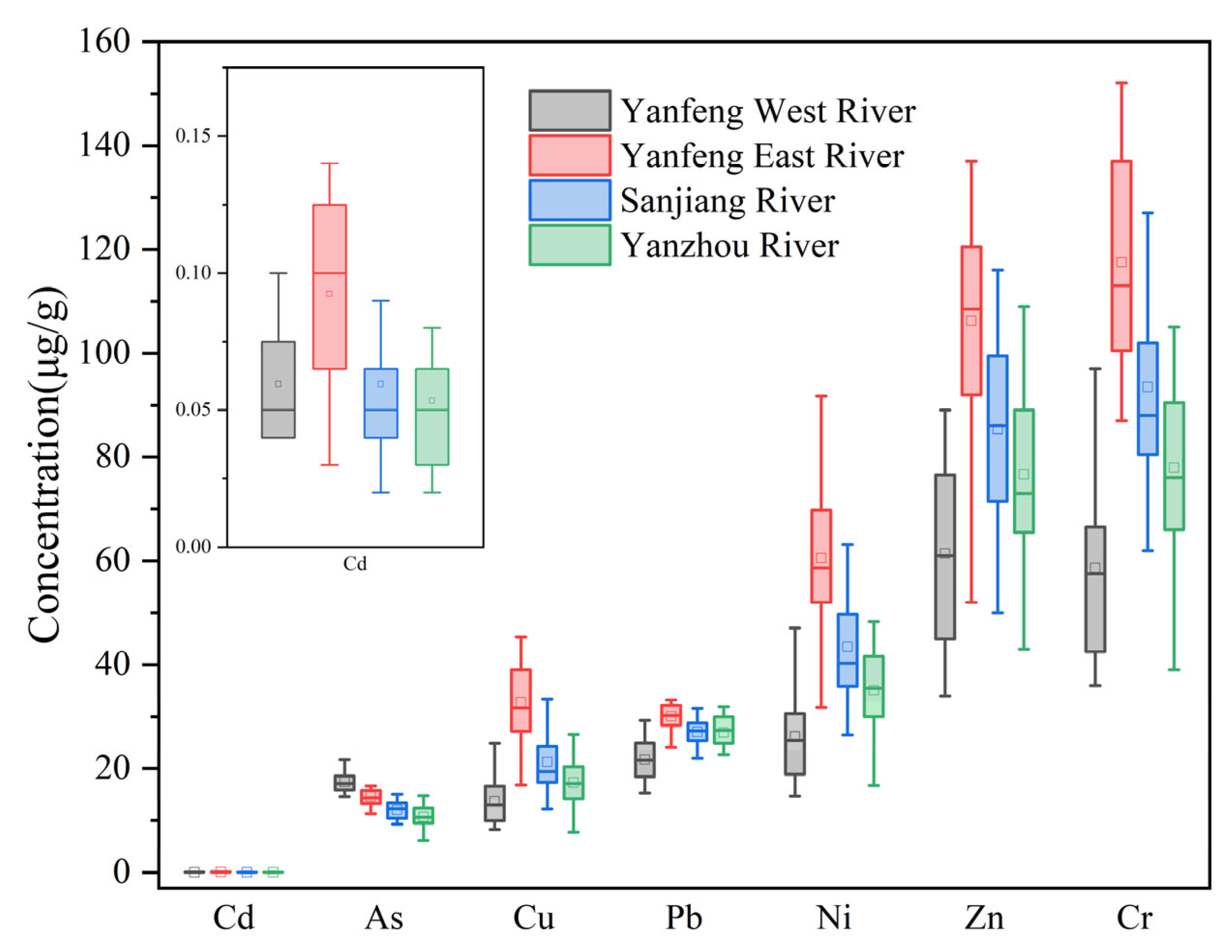
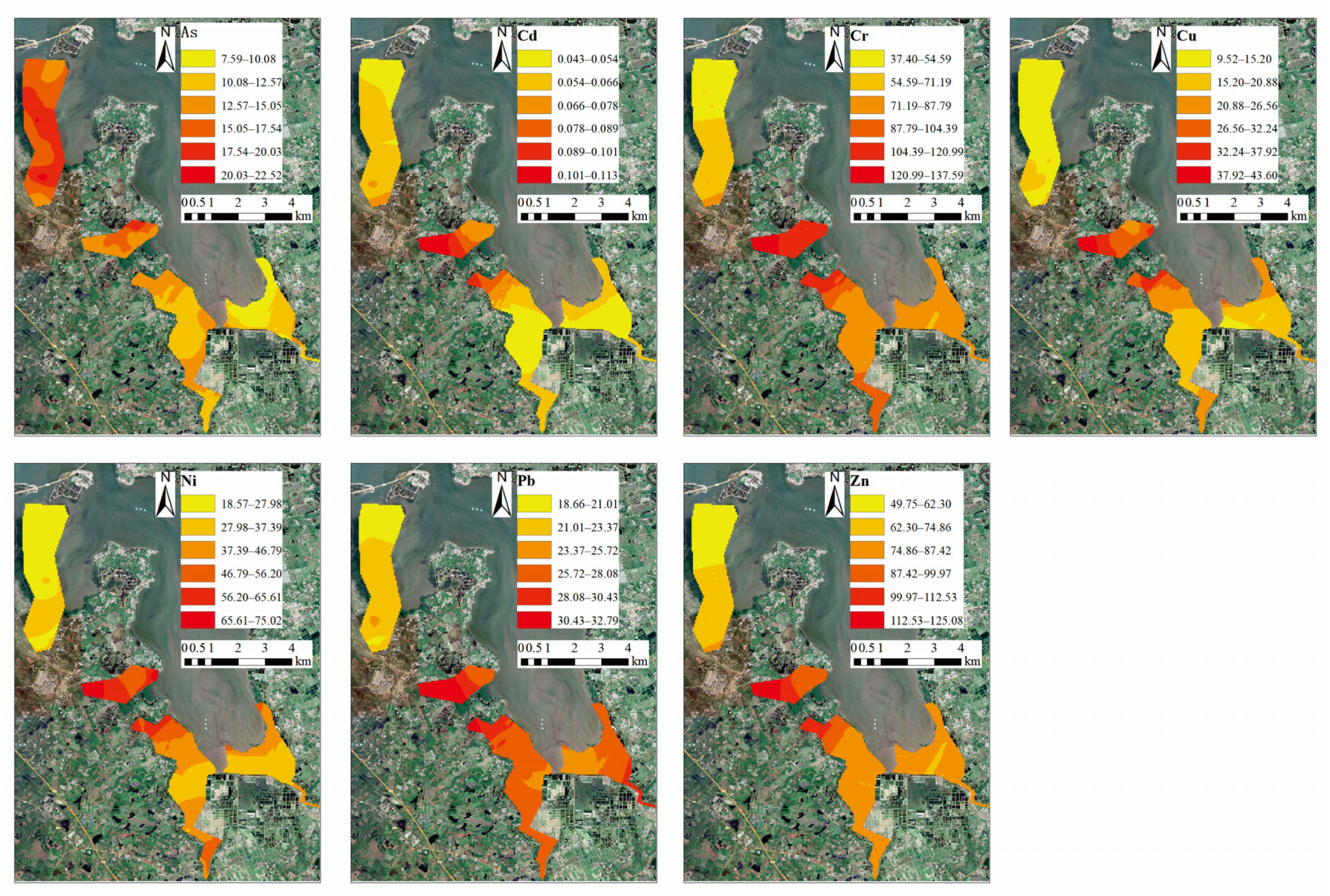
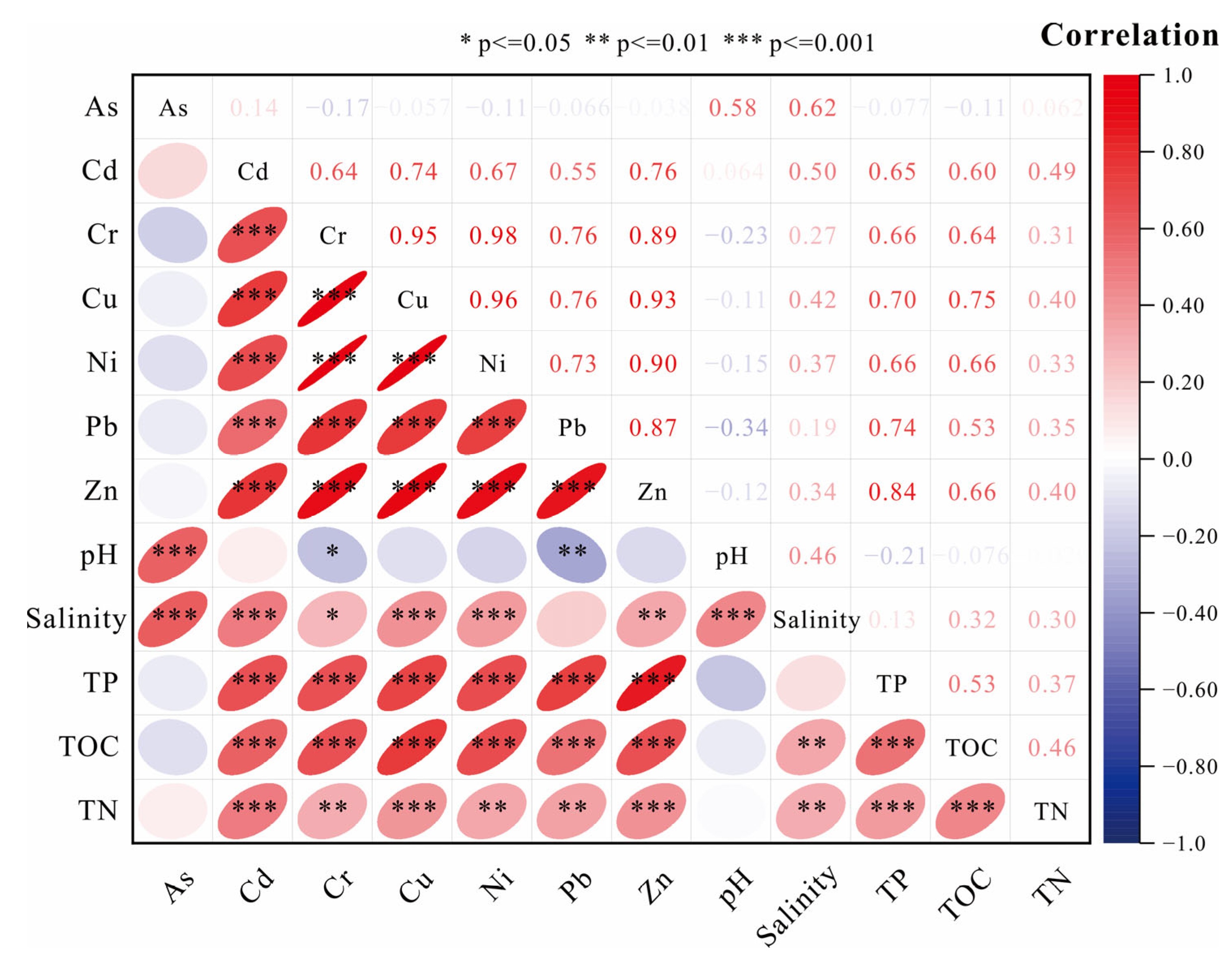
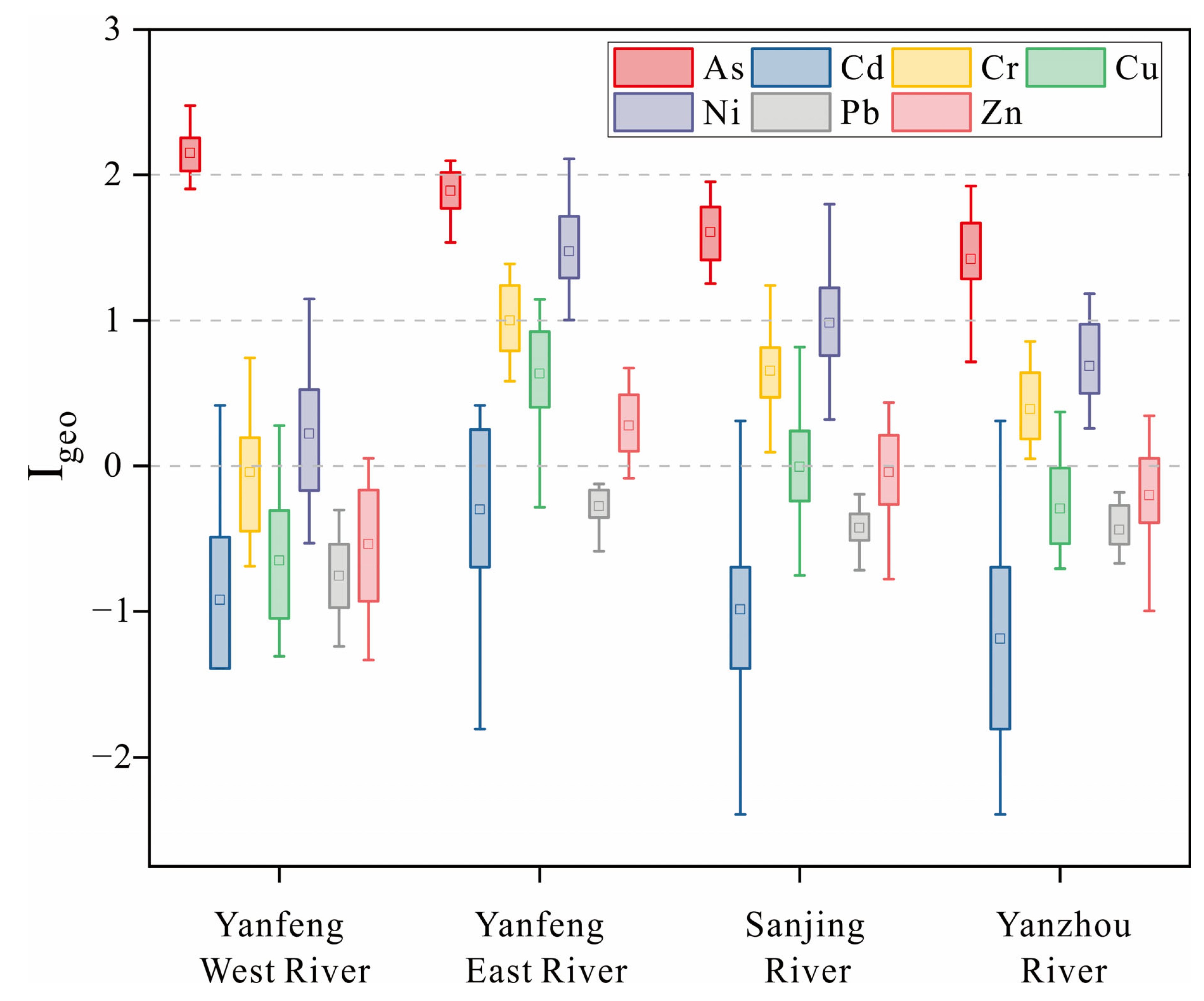
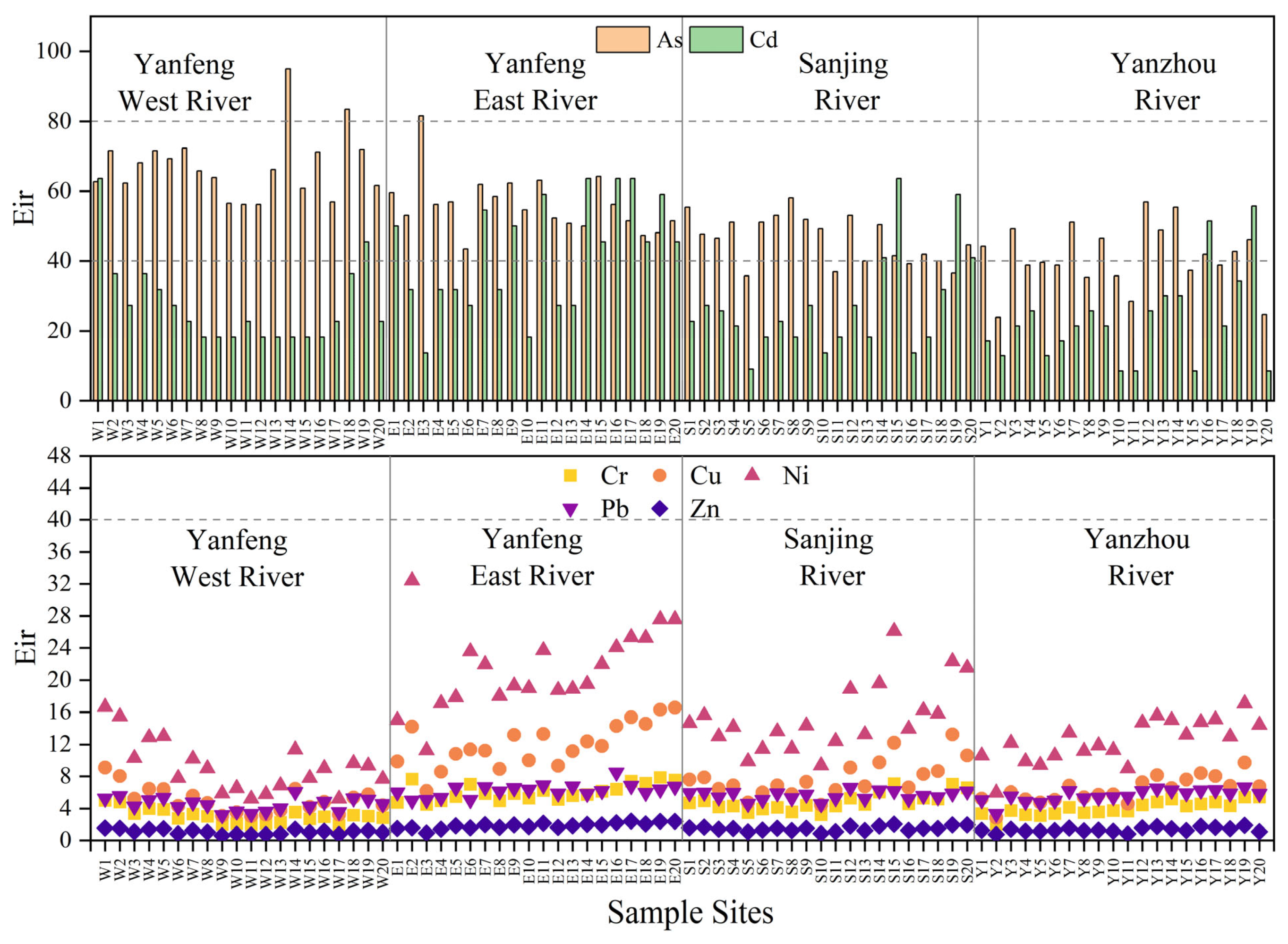
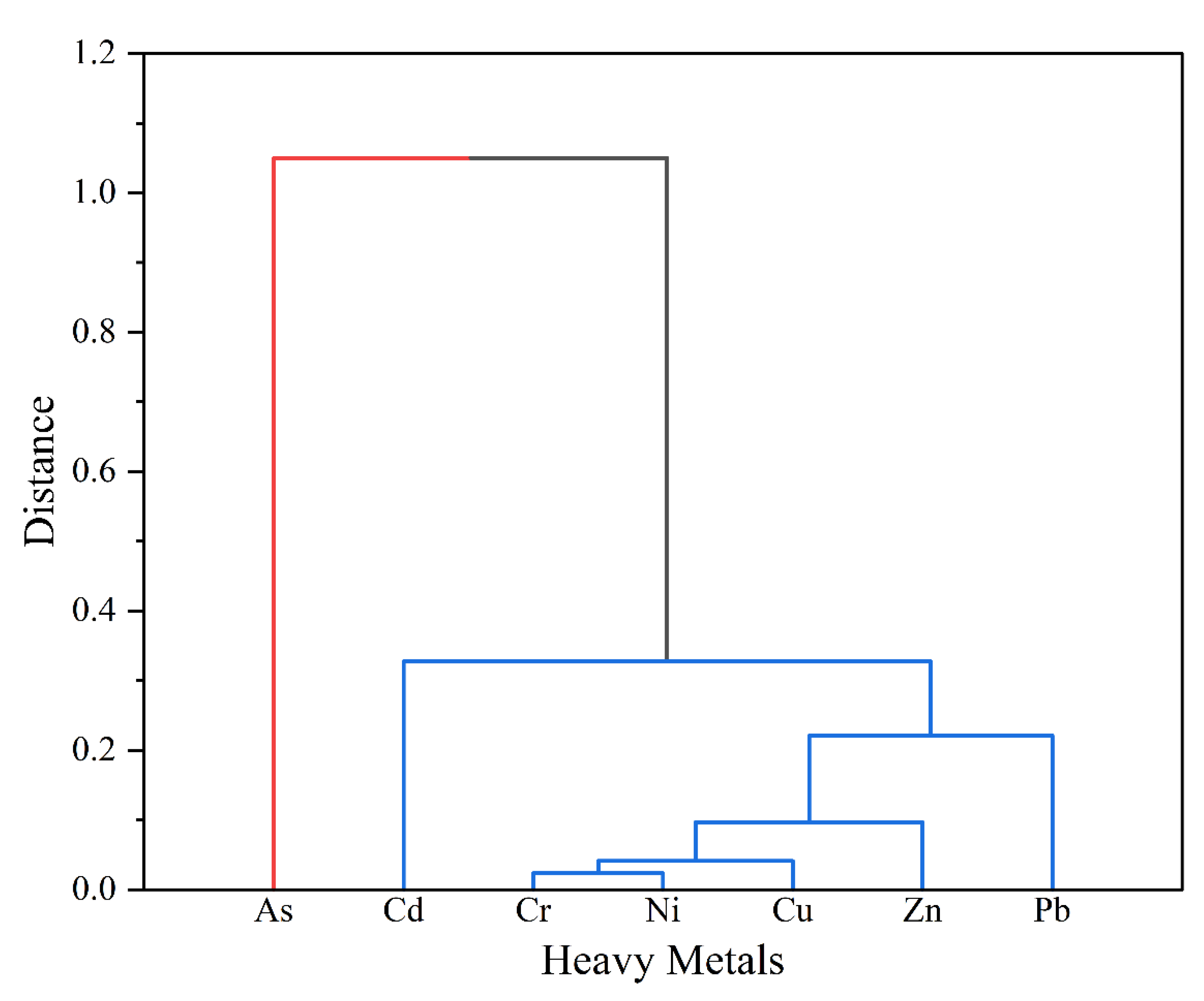
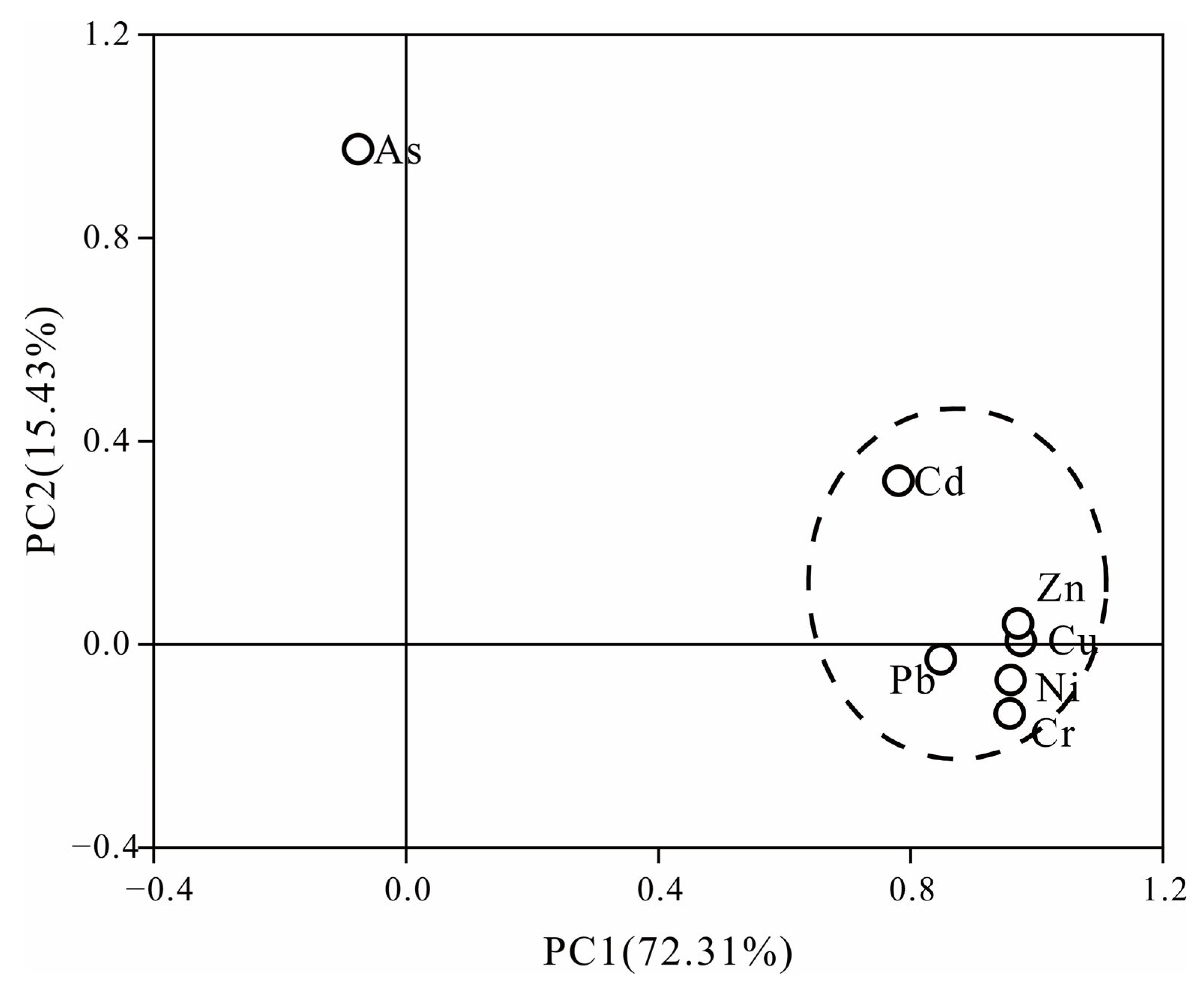
| Igeo | Level | Contamination Degree |
|---|---|---|
| Igeo ≤ 0 | 0 | No contamination |
| 0 < Igeo ≤ 1 | 1 | No contamination to moderate contamination |
| 1 < Igeo ≤ 2 | 2 | Moderate contamination |
| 2 < Igeo ≤ 3 | 3 | Moderate contamination to strong contamination |
| 3 < Igeo ≤ 4 | 4 | Strong contamination |
| 4 < Igeo ≤ 5 | 5 | Strong contamination to extreme contamination |
| Igeo > 5 | 6 | Extreme contamination |
| Description | RI | Description | |
|---|---|---|---|
| < 40 | Low ecological risk | RI < 150 | Low risk |
| 40 ≤ < 80 | Moderate ecological risk | 150 ≤ RI < 300 | Moderate risk |
| 80 ≤ < 160 | Considerable ecological risk | 300 ≤ RI < 600 | Considerable risk |
| 160 ≤ < 320 | High ecological risk | RI ≥ 600 | Very high risk |
| ≥ 320 | Very high ecological risk | – | – |
| Sampling Area | As | Cd | Cr | Cu | Ni | Pb | Zn |
|---|---|---|---|---|---|---|---|
| Maximum (μg/g) | 24.7 | 0.14 | 152 | 45.4 | 91.8 | 40.9 | 137 |
| Minimum (μg/g) | 6.2 | 0.02 | 36 | 7.8 | 14.7 | 15.3 | 34 |
| Mean (μg/g) | 13.7 | 0.07 | 86 | 21.3 | 41.3 | 26.5 | 82 |
| Coefficient of variation/% | 0.21 | 0.49 | 0.35 | 0.44 | 0.43 | 0.19 | 0.32 |
| Background (μg/g) | 2.6 | 0.07 | 39 | 13.7 | 14.2 | 24.1 | 57 |
| Over background (%) | 568 | 94 | 233 | 166 | 308 | 109 | 147 |
| Country (Region) | As | Cd | Cr | Cu | Ni | Pb | Zn | References |
|---|---|---|---|---|---|---|---|---|
| Mai Po, Hong Kong | - | 2.62 | 39.2 | 78.5 | 25 | 79.2 | 240 | [32] |
| Quanzhou Bay, Fujian | - | 0.181 | 68.1 | 42.5 | 28.1 | 12.28 | 184 | [33] |
| Sungei Buloh, Singapore | - | 0.181 | 16.61 | 7.06 | - | 12.28 | 51.24 | [34] |
| Port Jackson, Australia | - | - | - | 62–102 | - | 180–443 | 145–351 | [35] |
| Guanabara Bay, Brazil | 1.28 | 1.32 | 42.4 | 98.6 | - | 160.8 | 483 | [36] |
| Mazatlan, Mexico | - | 3.2 | - | 36 | - | 51.5 | 263.5 | [36] |
Disclaimer/Publisher’s Note: The statements, opinions and data contained in all publications are solely those of the individual author(s) and contributor(s) and not of MDPI and/or the editor(s). MDPI and/or the editor(s) disclaim responsibility for any injury to people or property resulting from any ideas, methods, instructions or products referred to in the content. |
© 2023 by the authors. Licensee MDPI, Basel, Switzerland. This article is an open access article distributed under the terms and conditions of the Creative Commons Attribution (CC BY) license (https://creativecommons.org/licenses/by/4.0/).
Share and Cite
Guo, Y.; Ke, X.; Zhang, J.; He, X.; Li, Q.; Zhang, Y. Distribution, Risk Assessment and Source of Heavy Metals in Mangrove Wetland Sediments of Dongzhai Harbor, South China. Int. J. Environ. Res. Public Health 2023, 20, 1090. https://doi.org/10.3390/ijerph20021090
Guo Y, Ke X, Zhang J, He X, Li Q, Zhang Y. Distribution, Risk Assessment and Source of Heavy Metals in Mangrove Wetland Sediments of Dongzhai Harbor, South China. International Journal of Environmental Research and Public Health. 2023; 20(2):1090. https://doi.org/10.3390/ijerph20021090
Chicago/Turabian StyleGuo, Yuan, Xianzhong Ke, Jingxian Zhang, Xinhui He, Qinghua Li, and Yanpeng Zhang. 2023. "Distribution, Risk Assessment and Source of Heavy Metals in Mangrove Wetland Sediments of Dongzhai Harbor, South China" International Journal of Environmental Research and Public Health 20, no. 2: 1090. https://doi.org/10.3390/ijerph20021090
APA StyleGuo, Y., Ke, X., Zhang, J., He, X., Li, Q., & Zhang, Y. (2023). Distribution, Risk Assessment and Source of Heavy Metals in Mangrove Wetland Sediments of Dongzhai Harbor, South China. International Journal of Environmental Research and Public Health, 20(2), 1090. https://doi.org/10.3390/ijerph20021090






